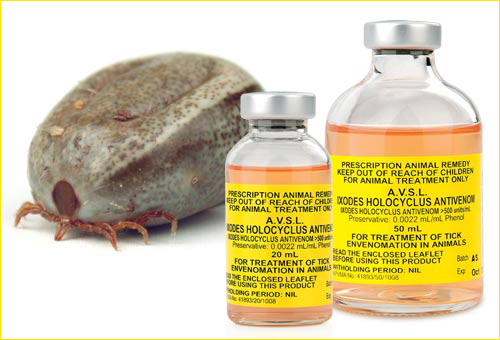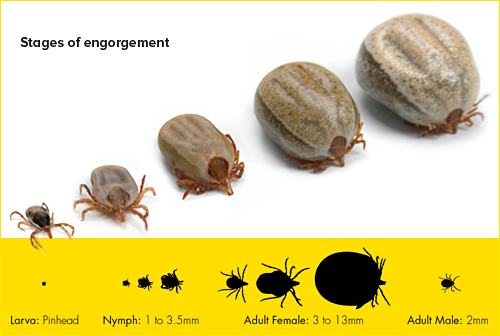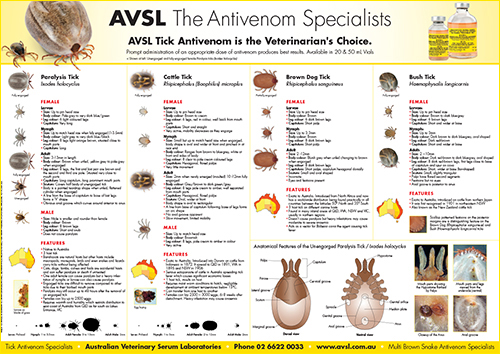
AVSL IXODES HOLOCYCLUS ANTIVENOM

• Powerful and effective treatment against tick paralysis
• Pure, consistent serum, quality controlled to APVMA standard
• Processed in our own APVMA accredited laboratory
• Available in 20ml and 50ml bottles.
TYPICAL CLINICAL SIGNS OF TICK PARALYSIS
The Australian paralysis tick, Ixodes holocyclus is a parasite that is responsible for the death of many thousands of animals along the Eastern coastline of Australia every year. Holocyclus toxin is comprised of many different components resulting in muscle paralysis, laryngeal paralysis, mega oesophagus and also cardiotoxic effects. The typical clinical signs and stages of tick paralysis are…
STAGES OF TICK PARALYSIS
Early Stages
- Dysphonia or loss of bark / meow
- Hind limb weakness and mild ataxia
- Vomiting
Later Stages
- Hind limb weakness progresses to an incoordinated wobbly gait
- Change in respiratory pattern – rhythm, rate, depth and effort
- Gagging, expiratory grunt or coughing
- Regurgitation or vomiting
- Loss of thermoregulation
Worsening Stages
- Animal becomes completely paralysed, unable to stand and may or may not be able to maintain sternal recumbency
- Respiration becomes laboured and difficult
- A stable tenacious frothy foam can develop in airways leading to worsening cyanosis
- Mega-oesophagus
- Cardiotoxic effects including myocardial depression and myocardial failure
- Stress can occur quickly in animals as their clinical signs progress
DIFFERENTIAL DIAGNOSIS
Includes all diseases and toxins resulting in lower motor neurone paralysis – snakebite, botulisim, hypokalameia, tetrodotoxins, ciguatera toxin, polyrediculoneuritis, organophosphate or carbonate intoxication, thromboembolic disease and meningitis/myelitis.


TREATMENT
Administer an appropriate dose of AVSL tick antivenom (> 500 ATT) as soon as possible. Doses of 10-15mL are usually given to an early stage cat or 10kg dog and up to 30ml for a large dog, foal or calf. Dilute antivenom dose 1:1 with saline and administer by intraperitoneal injection in cats. For dogs and other animals give by intravenous injection slowly over at least 20 minutes.
TREATMENT
- Administer an appropriate dose of AVSL tick antivenom (> 500 ATT) as soon as possible. Doses of 10-15mL are usually given to an early stage cat or 10kg dog and up to 30ml for a large dog, foal or calf. Dilute antivenom dose 1:1 with saline and administer by intraperitoneal injection in cats. For dogs and other animals give by intravenous injection slowly over at least 20 minutes.
- As much as practical provide a ‘stress free’ environment. If necessary sedation can be administered using Acepromazine 0.33ml/kg although beware of patients with already low blood pressure.
- Ensure no more ticks. Always more than one tick search and at least 2 different people. It may be necessary to clip an animal to ensure that no more ticks are present. Balance this against the increased stress it may cause.
- Suction of the mouth and throat may be necessary. Emergency tracheostomy may be necessary.
- Dyspnoea can be a major cause of exhaustion in cases. Early use of intranasal humidified oxygen can help counter such fatigue.
- Nil by mouth. Intravenous fluids at or just below maintenance may be necessary to prevent dehydration. See the AVSL FLUID CHART.
- Monitor temperature and if necessary place patient on heating pad or equivalent to maintain normal body temperature.
- Eye protection. Tick toxin can cause a local paralysis in eyelids resulting in a cessation of blink reflex and corneal drying and ulceration. Use a tear replacer such as Viscotears every 3-4 hrs.
- Monitor urine output. Some patients can develop a detruser muscle atony with prolonged hospitalisation and may require catheterisation
- Do not reintroduce water or food until gag reflex has returned and commence with SMALL amounts only.
USEFUL LINKS
A very comprehensive précis of the Australian paralysis tick Ixodes holocyclus. Becoming a little bit dated but still a thorough and detailed resource.
Good detail regarding taxonomic identification of Ixodes holocyclus
Further tick information


